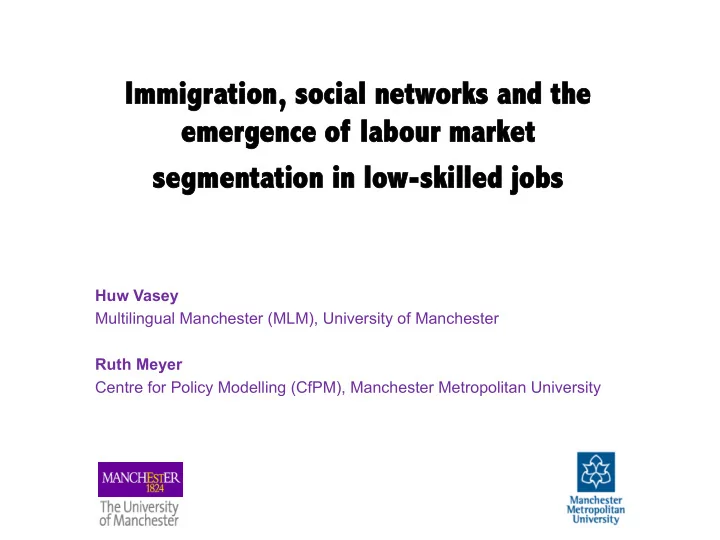

Immigration, n, social ne networks and nd the he emergenc nce of labour ur market -skilled jobs segment ntation n in n low-s Huw Vasey Multilingual Manchester (MLM), University of Manchester Ruth Meyer Centre for Policy Modelling (CfPM), Manchester Metropolitan University
The project in a nutshell… or why study ethnic segmentation in low-skilled labour markets? • Ethnic n c niches form in certain labour market areas; • Why? two broad themes: – Employers and dominant ethnic groups discr crimi minate against new immigrants; – ‘Birds o of a a f feather f flock t together’ – co-ethnics tend to prefer working together for a variety of reasons (including the sharing of information, easier access to opportunities and a level of protection from discrimination).
The project in a nutshell continued… • Ethnic segmentation happens… but what are the formative dynamics in the LM? – What role does discrimination play vs ethnic networks? – Why certain niches and not others? – How are these processes affected by population size, distribution of jobs and other demographic processes? • These are complex processes which would benefit from being investigated using an agent-based modelling approach.
The LaMESt model • La Labou bour M Mar ar ket ets an and E Ethnic thnic Segme mentation mo model • Takes inspiration from m Wa Waldinger & & Li Lichter’s (2003) semi minal text: “Ho How the O Other Ha Half W Works” – Based i in e early 1 y 1990s LA LA – Ha Has a particu cular interest in ho how w et ethnical cally homo omogen enou ous soci ocial al networks reinforce ce proce cesses of labour ma market segme mentation by y ethnic g c group i in l low-skilled j jobs – This has been widely y ci cited and acce ccepted in studies of immi mmigration and l low-skilled w work
Specifying the model Most job-seekers activate their social connections to find jobs… Employers use ties linking the workers whom they know to the new people they may like to hire (Waldinger & Lichter, 2003: 83) Social networks provide: i) information - ‘telling job seekers about opportunities and informing employers about the characteristics of applicants” – and, ii) influence – ‘allowing job seekers to put themselves on the inside track by proxy’
The model
FINDINGS GS
Impact of social networks on segmentation Eth0/blue = African-Americans; Eth1/red = Mexican (large); Eth2/green = Asian (small). Figures show averages of 10 runs.
‘Internally-conservative’ discrimination (H-index) Eth0/blue = African-Americans; Eth1/red = Mexican (large); Eth2/green = Asian (small). Figures show averages of 10 runs.
‘Internally-conservative’ discrimination (Population size) Eth0/blue = African-Americans; Eth1/red = Mexican (large); Eth2/green = Asian (small). Figures show averages of 10 runs.
‘Externally-conservative’ discrimination (H-index) Eth0/blue = African-Americans; Eth1/red = Mexican (large); Eth2/green = Asian (small). Figures show averages of 10 runs.
‘Externally-conservative’ discrimination (Population size) Eth0/blue = African-Americans; Eth1/red = Mexican (large); Eth2/green = Asian (small). Figures show averages of 10 runs.
Impact of initial group size (H-index) Fi Final al He Herfindahl i index a after 3 30 y years 0.45 0.4 0.35 0.3 0.25 0.2 0.15 0.1 0.05 0 "[300 20 0]" "[270 50 0]" "[240 80 0]" "[220 100 0]" "[190 130 0]" "[160 160 0]" eth0 eth1 Eth0/blue = African-Americans; Eth1/red = Mexican
Impact of initial group size (Population proportions) Final p population p proportions 0.9 0.8 0.7 0.6 0.5 0.4 0.3 0.2 0.1 0 "[300 20 0]" "[270 50 0]" "[240 80 0]" "[220 100 0]" "[190 130 0]" "[160 160 0]" eth0 eth1 Eth0/blue = African-Americans; Eth1/red = Mexican
Key points • Our research has illustrated that: – Ethnica cally h y homo mogenous s soci cial n networks s significa cantly i y incr crease ethnic s c segme mentation i in t the l labour ma market • This impact outweighs that of the ‘conservative’ discrimination procedures tested – Such homo mophilic n c networks a also e enhance ce t the a ability o y of immi mmigrant g groups t to g gain a a f foothold i in t the l labour ma market, particularly under conditions of discrimination – These findings broadly support the findings from a previous model of a similar scenario (Abdou & Gilbert, 2009)
Questions raised, and some intriguing new findings • How do ethnically-homogenous networks evolve once a niche has been formed? – Do they then become a barrier to labour market progressions (and, indeed, social integration) – Or do they mutate and dissipate as migrants learn the dominant language and culture-specific norms as human-capital • How does discrimination ‘really’ happen in the labour market and how can this be modelled? – Recent research has suggested that labour market discrimination within a complex ‘call and response’ (McDowell et al., 2007) between employer and potential employee about what sort of worker is suitable for which kind of job. ICD and ECD discrimination represent two (unsophisticated) variants of this, but would subtler forms be worthwhile to investigate? • Ethnic segmentation seems to require a ‘reserve army of labour’ to develop – Where labour market shortages occur segmentation does not occur, even when employers are discriminating • But… it appears fastest where there is a growing labour market vacuum – In the LA sample we are modelling a scenario where the (hidden) majority population is moving out of low-skill work leaving gaps in the labour force, when this isn’t included, immigrants are ‘locked out’ for longer and we see far lower levels of segmentation (eventually)
Thanks for listening! huw.vasey@manchester.ac.uk ruth@cfpm.org
Herfindahl Index (H-1/N) H* = 1-1/N N = number of firms in the model, s i = the proportion of ethnic group i employed in the firm. The index varies between 1 (very high segmentation by firm) and 1/N (no segmentation) H* = normalised Herfindahl index
Recommend
More recommend